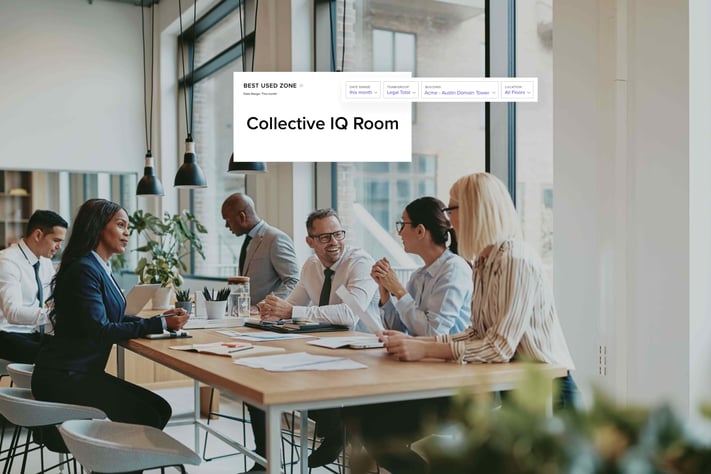What is your hybrid office perfect for? Think like a product designer to find out
The COVID-19 pandemic proved to millions that it’s possible to work remotely. But that doesn’t mean it’s desirable in every instance. More people want to be in the office, if only for a day or two per week, to connect with colleagues and get a change of scenery from their home office (or dining room table).
But on top of work styles and remote work, the physical office space is also going through changes.
Pre-pandemic, there was a compression in the workplace. Companies began to adopt and implement hoteling or shared workspaces to figure out how to get more people using less space. At the time, this shift was primarily driven by cost cutting as real estate continued to get more expensive in major cities.

With more remote work and hybrid offices, the compression process has continued to leap ahead. However, the driving force has changed. Instead of asking about the most cost-efficient way to house every employee in an office, it’s about creating the most effective hybrid office layout for employees when they are in the office, knowing other times they can simply work from home (or a cafe, or a coworking space).
With a new question in mind—asking what the office is perfect for and how to make a successful hybrid workplace—it’s critical for CEOs and CFOs to think more like cost-aware product designers than spreadsheet number crunchers.
Your office is a product, treat it like one
The physical space of an office, the connections made, and the work done makes the office seem like a home for your company. In many ways that’s true, but it’s also a product with an expected outcome—productivity.
To better understand what kind of hybrid office design works best for your organization, think like a product designer.

In product design, we hypothesize what will work, but we’re usually proven wrong once we go into testing in the real world and people start using it. This is the exact stage we’re at with hybrid workplaces and offices. We think we know what works—the pandemic showed us that we’re productive when working solo from home but crave connection in an office—and are designing from that hypothesis. However, it’s critical to see what people actually do in a space rather than build everything from an idea.
“Starting with a hypothesis is important, but we need to assess different types of workspaces and see what people gravitate towards,” said James Wu, CEO and founder of InnerSpace.
Your employees are your users
In order for your office to achieve productivity, it’s important to recognize that a physical office needs to do different things for different people/different groups (departments, teams, etc.).
Different roles have different requirements of space, for example:
- Executives: they need private office space to host confidential meetings and there is often status involved (meaning they typically demand more space in a more comfortable layout).
- Accounting and finance teams: they need quiet space for deep work with additional importance given to the confidential nature of their work.
- Sales teams: they need collaborative space and space where they can be noisy as they take meetings and calls without interrupting anyone else (or each other).
“Everyone needs something different out of a hybrid office space," said James. "An engineer, for example, needs something very different compared to sales, executives, or the legal team."

There are also different types of tasks that stretch across teams or functions such as whiteboarding, team lunches, quarterly reviews, or job interviews. But these use cases only serve to add complexity—now it’s not just individual roles but also individual use cases that might stretch across roles. For example, many different people might participate in an interview or the same room used for interviewing could also be used for regular employee-manager one-on-ones. There's also the question of how to include full-time remote workers, meaning additional technology will be part of the hybrid office design.
Ultimately, existing office space must be redesigned to fulfill multiple, different needs. And this must be done under the umbrella that the office is for everything that isn’t doable at home. This truth is why there is a conflict between employers and employees over current hybrid models.
There is no universal insight yet, and each company has to do the work to identify what its space is perfect for and, from there, build a plan for its hybrid office.
What is your office perfect for?
The general hypothesis is that people want to use offices for activities that require physical interactions between colleagues to be more effective. This flies in the face of the old formula of being in an office every day, or even a certain number of days per week.
-min.png?width=620&name=inTELLO_People-Metric%20(1)-min.png)
This is how InnerSpace can be employed—to gather insights and data around how and when space is best used. With InnerSpace, companies can measure mobility and interactivity of a team or teams to better inform hybrid office layout plans based on which teams are interacting, which resources overlap between team needs, and what collaboration looks like in your organization.
By digging deeper into the data and insights, you start to gain a clearer picture of what needs to be done to foster that thing—collaboration—you’re going for. You need a scientific, data-driven analysis of your office rather than relying solely on what people say they need (or think they need). This is what InnerSpace calls "Indoorology," the study of how to find the perfect office space layout for every use case or context.
When identifying what your office space is perfect for, you can’t paint every employee and team with the same brush with regard to what is needed at the office. You need to be able to think more granularly and to understand that different teams operate differently. If you broad-stroke your solution, you average away all the opportunities for real improvement. Instead, you need specific metrics based on what you need to accomplish and how people actually use the space they are provided.
Accurate space utilization data through Wi-Fi?
We'll prove it to you.
See why industry leaders leverage InnerSpace to generate valuable insights that go beyond occupancy.

